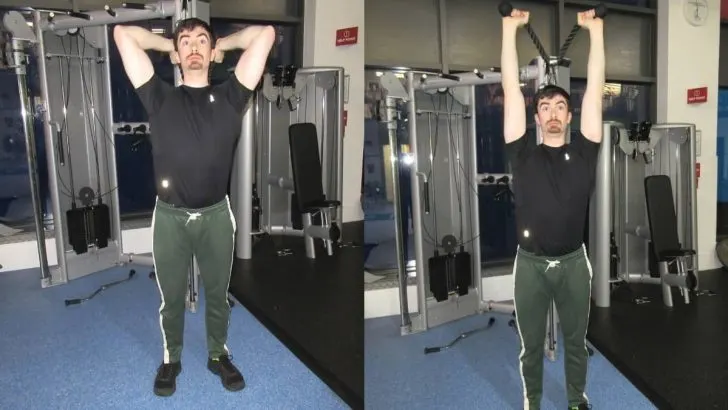The cable overhead tricep extension challenges your triceps with constant tension to create an intense muscle pump and a potent hypertrophic stimulus.
The overhead rope extension is also one of the most effective tricep pulley exercises for building symmetrical upper arms because, at the end of the rep, you’ve got to lock out each side of the rope separately. This means that you’re less likely to develop muscular imbalances because both of your triceps are receiving similar amounts of work from the overhead cable extension.
This guide shows you how to do 11 different variations of the cable tricep extension with the proper muscle-building form. After that, we’ll discuss and correct 3 common rope extension mistakes that lifters make when performing this exercise. This way, you can avoid injury while ensuring that you get the best possible results from your cable rope extension efforts.
Related: Tricep pushdowns vs overhead extensions
Overhead cable extension exercise details
- Also Known As: Overhead cable pull, overhead rope press, overhead tricep pull
- Main Muscles: Triceps
- Exercise Type: Strength
- Exercise Mechanics: Isolation
- Difficulty Level: Beginner
- Equipment Needed: Cable column, rope attachment
How to do an overhead rope tricep extension
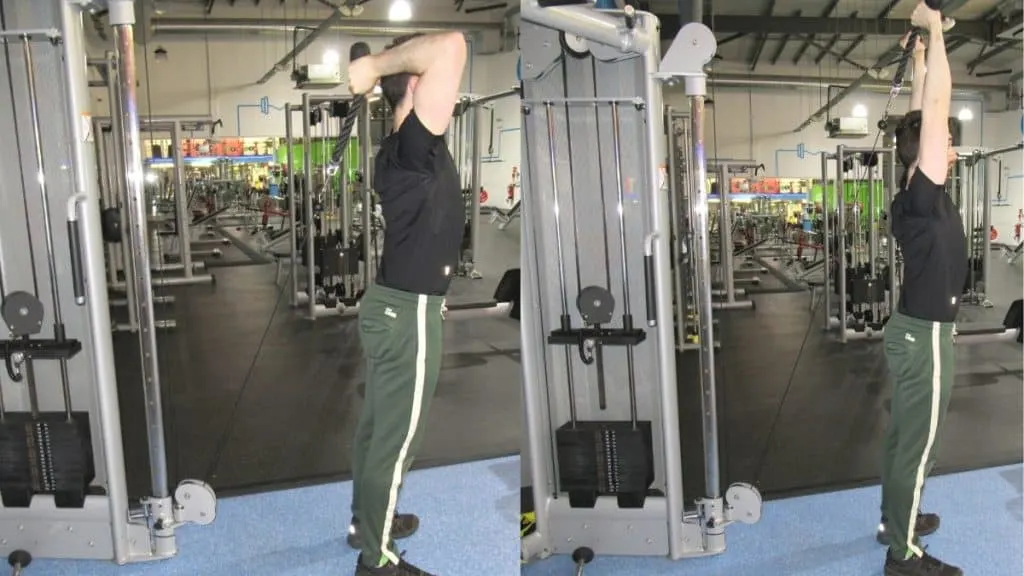
- Position the pulley around waist height and connect a rope attachment. If the pulley on your machine isn’t height-adjustable, use the low pulley rather than the high pulley.
- Grab each end of the rope with a firm grip.
- In one swift motion, turn your body away from the cable station and place your arms behind your head so that your elbows are bent, and your triceps are stretched.
- Tuck your elbows in slightly and then forcefully flex your triceps until your elbows reach complete extension.
- “split” the triceps rope at the end of the rep by moving the ends of the rope away from each other.
- Lower the rope under control (descend until you feel an intense stretch in your triceps) and then perform another rep.
- Do 3-5 sets of 8-15 reps in total.
Overhead rope extension muscles worked
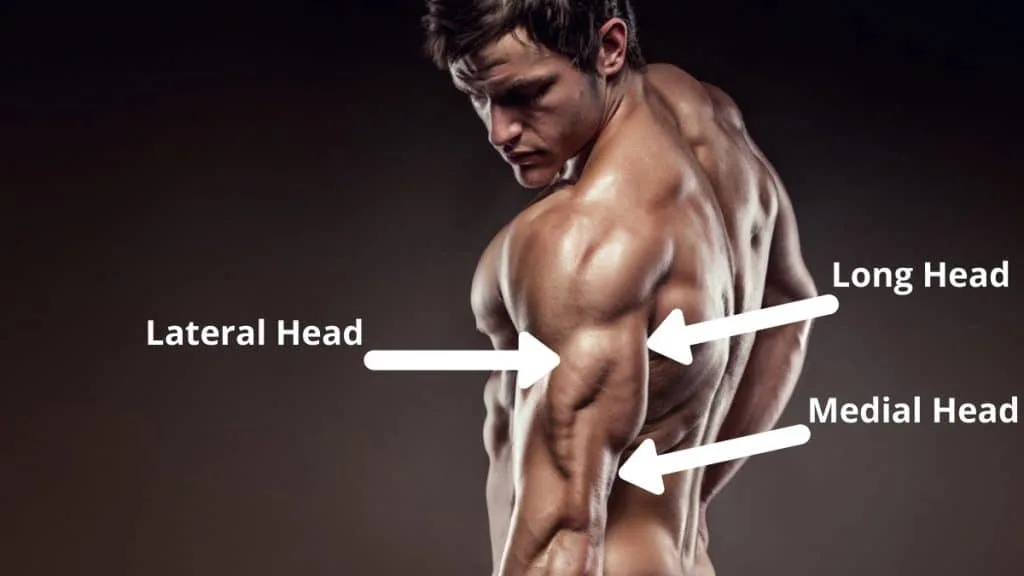
The overhead rope extension exercise works all three heads of the triceps brachii muscle due to its elbow extension component. [1] However, because you’re shoulders are in flexion during an overhead cable extension, the exercise gives extra emphasis to the long head of the triceps because this is the only head of the triceps that crosses the shoulder joint.
As such, when you place your arms over your head and perform any kind of elbow extension, the long head naturally receives an intensified eccentric stretch because it’s the only head that can act on the shoulder joint. Thus, the long head of the triceps performs most of the lifting during the cable rope overhead extension.
Overhead cable tricep extension variations
Learn the pros and cons of the different attachments and pulley positions by checking out 10 additional variations of cable overhead extensions. Which version is optimal for building the triceps?
Like many things in strength training, the best exercise depends on your goals, equipment availability, and individual weak points. More on that right now.
One arm cable overhead tricep extension
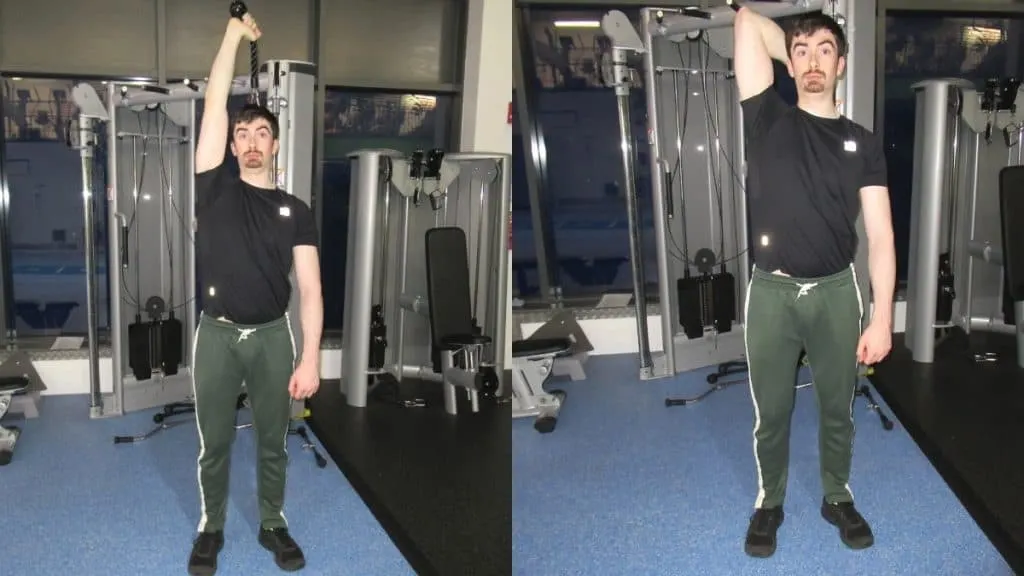
The one arm overhead cable tricep extension is the best choice for developing symmetrical triceps because the exercise forces you to train each arm separately. This means that your stronger side can’t dominate the movement, which in turn means that both of your triceps will receive similar amounts of stimulation.
Why just similar and not equal stimulation?
Because it’s likely that you’ve got a better mind-muscle connection with one of your triceps, which is to say that you have an easier time activating that particular triceps muscle. Well, even given equal reps and sets, the muscle that you can more easily activate will still receive more tension since you’re able to make it work harder.
Yet, this disparity in mind-muscle connection is precisely what the one arm overhead cable tricep extension can help resolve.
Since you’re training each arm by itself, your brain doesn’t have to split its focus across two limbs. This means that you can put more energy and focus into training both of your triceps to the best of your ability.
So if you have muscular imbalances or just want to sculpt symmetrical triceps, then the one arm overhead rope extension is an excellent exercise for developing more proportional arms. [2]
The only downside is that you’ll need to perform double the number of sets when you’re training unilaterally. Since there’s no need to rest between arms, however, the additional time commitment isn’t huge and will likely be worth the symmetry gains.
Seated tricep rope extension
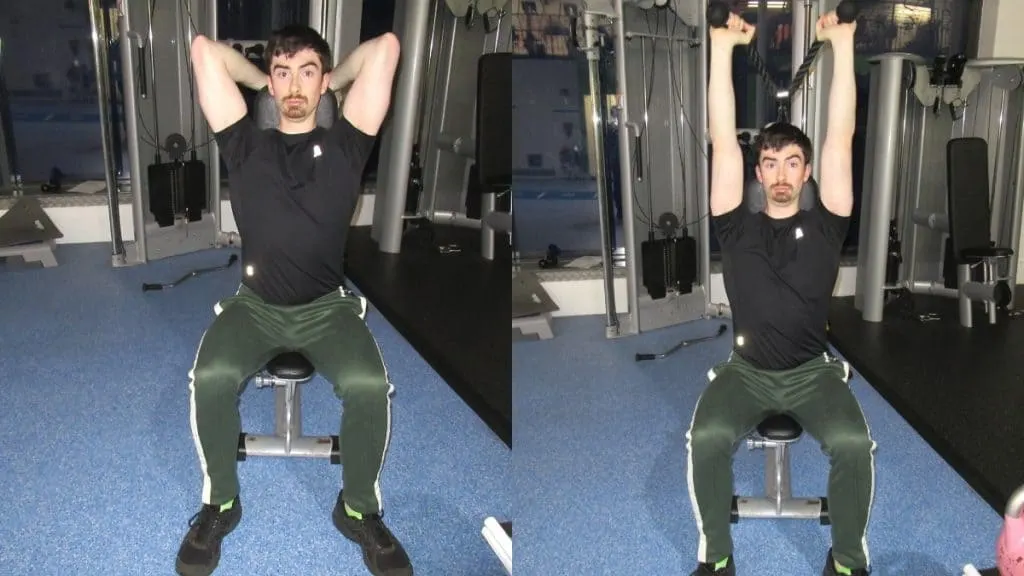
The seated overhead cable extension enables you to focus purely on training your triceps because it requires less abdominal exertion than the standing overhead cable tricep extension. This is because your back is braced against the bench’s pad.
When you don’t have to contract your core muscles as hard—in other words, when you don’t have to put as much work into the stability portion of the exercise—you can put more effort into training the target muscles, which, after all, is the whole purpose of an isolation exercise like an overhead cable rope extension.
The downside of not having to stabilize your torso as much (depending on your point of view) is that you won’t burn as many calories. [3]
Similarly, your abs won’t get much of a workout when you’re doing the cable extensions exercise sitting down (you can, of course, train your abs separately).
As such, if you’re training for fat loss, then it’s a good idea to stick with the standing cable tricep extension. After all, you won’t take much of a hit in triceps activation if you’ve already established a solid mind-muscle connection via years of weight lifting.
Still, for maximum triceps isolation, it makes sense to do the seated version. The only real downside is that the seated variation is more complicated to set up because you need access to a bench and a cable column.
Kneeling cable overhead triceps extension
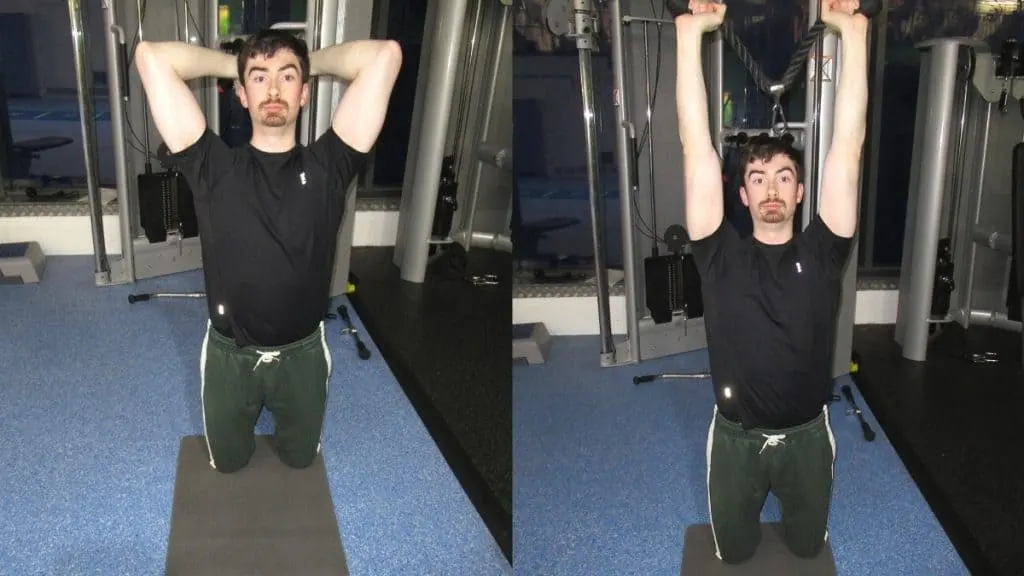
The kneeling cable triceps extension has two main use cases: One, those who want to increase the activation of their ab muscles, and two, those using a cable station that isn’t adjustable.
Assuming a tall kneeling position and then holding a heavily weighted cable attachment behind your head demands a lot of core strength. So if you want to give your abs a good isometric workout while taxing your triceps, then the kneeling overhead tricep cable extension is a great exercise for the job.
On the other hand, if your gym doesn’t have an adjustable cable station, then it makes sense to use the low pulley rather than the high pulley because performing the exercise with a low pulley places your triceps under a more substantial eccentric stretch.
You can, of course, perform the overhead tricep rope extension in a standing position and still use the low pulley. However, it’s easier to get the rope behind your head (especially if you’re lifting heavy) when your arms and shoulders are closer to the pulley, which is why the kneeling position is recommended for those using non-adjustable cable machines.
V bar overhead cable tricep extensions
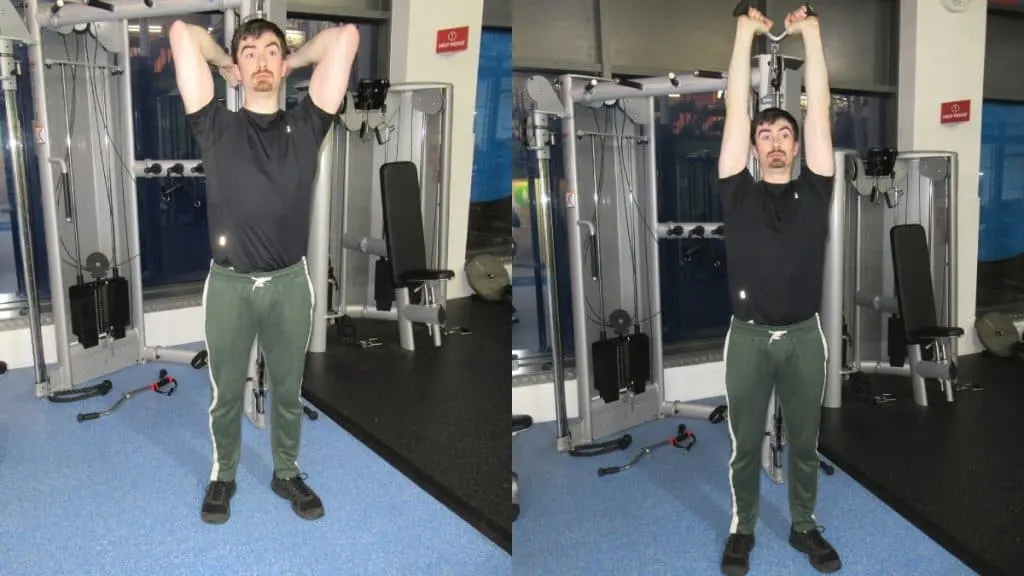
Overhead v bar extensions are very similar to the cable rope tricep extension. In fact, in terms of lifting technique, the two exercises are identical.
The difference is that the v-bar version requires less stabilization than the rope variation because a v-bar is one solid attachment, whereas the rope has two separate ends that you need to lift with each of your arms.
So while the cable rope triceps extension provides a better peak contraction and more balanced muscle stimulation, the v-bar version enables you to lift slightly heavier because the bar is easier for your triceps and shoulders to stabilize than the rope.
Of course, when you’re using any kind of bar attachment, your hands are forced into a predetermined position, which might not be comfortable for your wrists. Using a rope, on the other hand, enables you to keep your wrists in a neutral or semi-pronated position while forcing both of your triceps to lock out their section of the rope, thus promoting even muscular development.
Overhead cable extensions with a bar
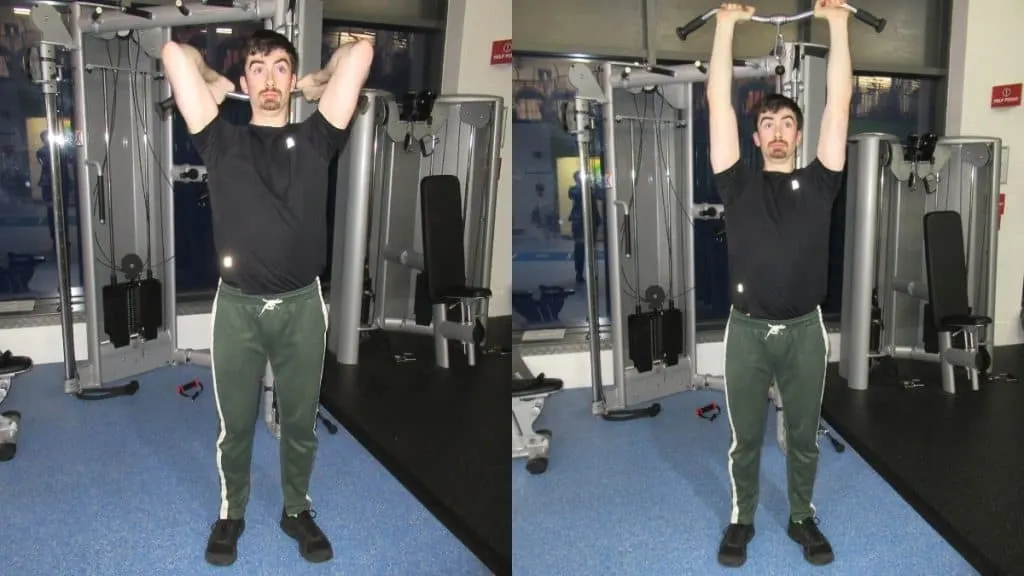
The overhead bar extension makes a great addition to any cable extensions workout because using a bar attachment enables you to overload your triceps with more resistance than any other pulley triceps exercise.
While straight bar attachments are more common, your best bet is to use a curved bar because these bars have semi-pronated grips that are much more comfortable to hold than those of straight bars.
The only drawback is that doing an overhead cable triceps extension with a bar rather than with a rope increases your chance of developing muscular imbalances because your stronger side could dominate the movement.
With rope tricep extensions, on the other hand, each of your arms has to lift its own side of the rope, which leads to more balanced triceps development.
Reverse grip cable triceps extension

Performing the reverse grip overhead triceps extension with cables gives your triceps a great pump because cables naturally provide constant tension, seen as the pulley is always exerting some kind of force on your muscles.
Yet, using a reverse grip for tricep cable extensions makes it harder to hold the bar. Since you can’t push into the bar with your palms when you use a reverse grip, you can’t apply as much force, which in turn means that you won’t be able to lift as much weight. Ultimately, your triceps will be getting less stimulation when you do standing cable extensions with a supinated grip.
But doesn’t using a reverse grip help you to keep your elbows tucked in?
Using a reverse grip for cable overhead tricep extensions encourages you to keep your elbows tucked in. However, since the triceps don’t act on the wrist, changing your hand position doesn’t actually force you to alter your elbow position.
In other words, it’s completely possible to rotate your hands without moving your elbows an inch.
Now, that said, the body does like to work in sync. So when you rotate your wrists, your elbows and shoulders are highly likely to move as well unless you consciously resist.
Anyway, a moderate amount of elbow flare during a rope extensions exercise is okay, providing that it doesn’t become excessive, in which case you might end up with elbow pain after your tricep workout.
Incline tricep cable extension
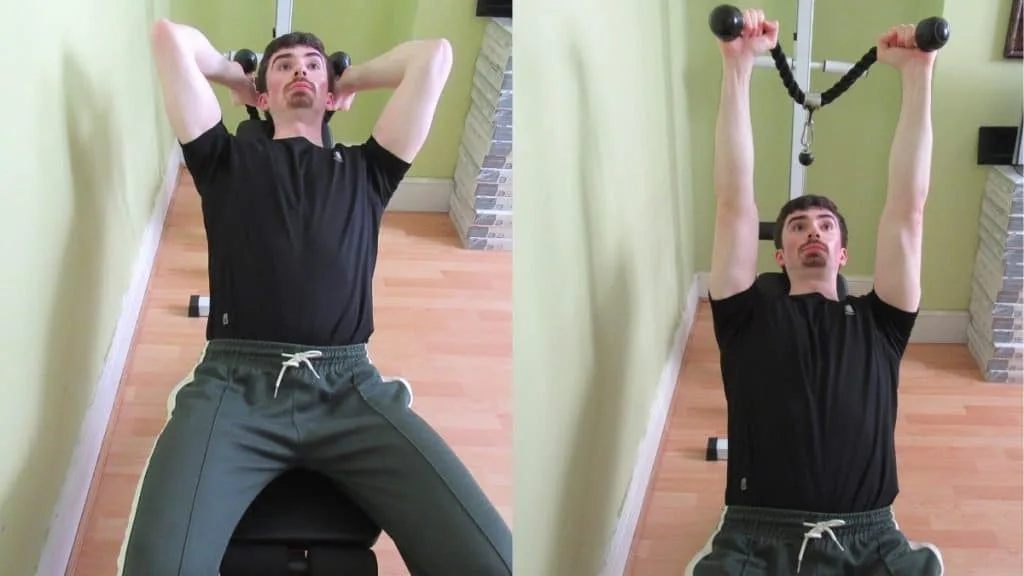
The cable incline triceps extension is a cross between the tricep rope overhead extension and lying cable extensions; you’re not laid horizontally, but your torso isn’t completely vertical either.
Since it doesn’t require you to put your shoulders into maximum flexion like the cable overhead extension, the incline rope extension (you can also use a bar) is ideal if you have overhead tricep extension shoulder pain.
The main downside is that the setup is more complicated—and in more ways than one.
First off, you have to wheel a bench over to the cable station, which is easier said than done at peak gym times (and in which time you have to hope that someone hasn’t hopped on your cable machine).
Second, unless you perform the exercise from a low pulley (in which case getting the rope into position would be a nightmare), the incline extension doesn’t put your triceps under the same intensity of stretch that the standing cable triceps extension does.
So while the incline rope extension exercise puts less pressure on the rotator cuffs, it doesn’t place as much tension on the triceps.
Isolateral cable overhead extension
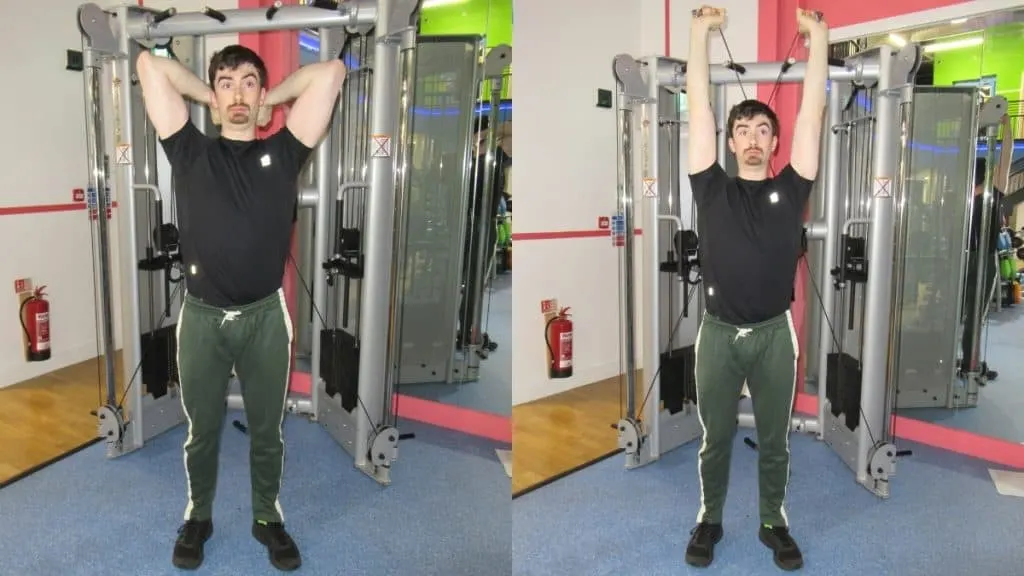
If you want to work your tris equally without spending extra time to train them in a unilateral fashion, then the isolateral overhead rope tricep extension is the best exercise for the job.
During an isolateral cable overhead triceps extension, you have to lift one cable pulley with each arm, which helps you to avoid developing tricep size asymmetries. Yet, because you’re training both arms together (in the same way that you’d do a dumbbell exercise), your sets won’t actually take any longer to get through.
The only requirement is that you use a compact cable station so that you can keep the pulleys behind you and thus place the long head of your triceps under an optimal eccentric stretch. If you were to attempt this exercise using a long cable crossover, then your elbows would flare out excessively, and it would be harder to get the cables in position.
Similarly, there’s no need to use any attachments for isolateral overhead cable extensions; the rubber balls on the ends of the cables are ideal for gripping. If your machine doesn’t have these, then you can just use two single handles or, if you’re rich in attachments, two single ropes.
Alternating cable overhead extensions
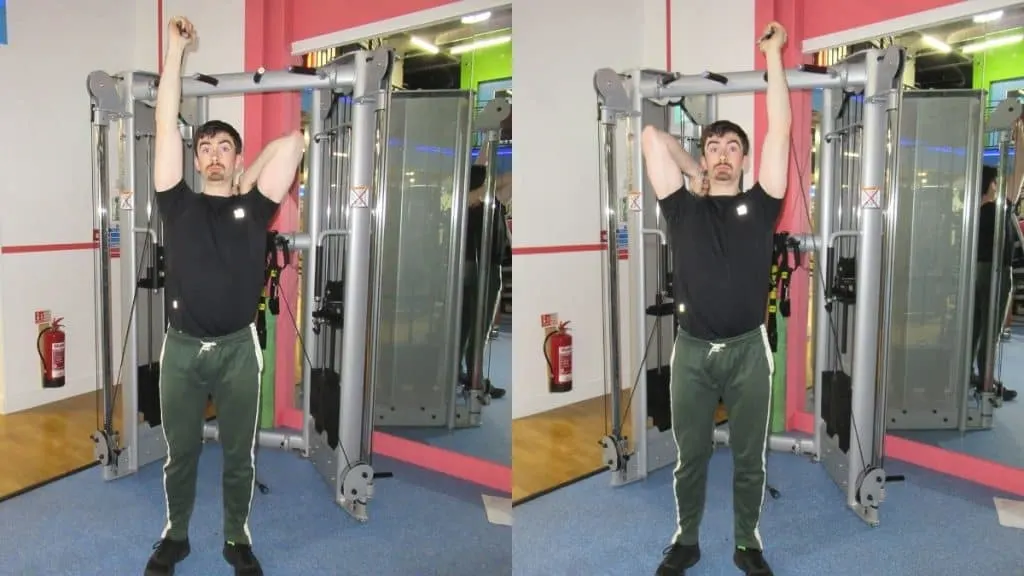
The alternating cable tricep overhead extension is strikingly similar to the isolateral version that you saw above.
The difference is that the alternating variation enables you to perform more reps per set because each of your triceps gets a brief rest while the other is working.
In order to get this benefit, however, you need to keep your non-working arm locked out so that it has a chance to rest. If you just leave your arm stretching behind your head, then it will actually get more fatigued, which means that you’ll naturally perform fewer reps on each set (the opposite of what we want).
Overhead cable pulls
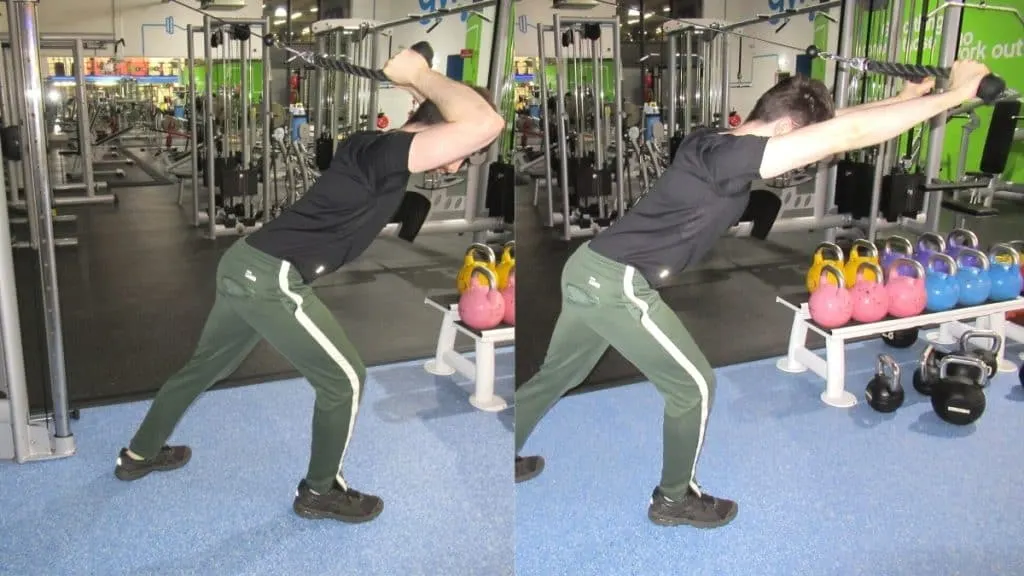
The overhead rope pull is a variation of the standard tricep overhead cable extension, where your torso is completely straight and the pulley is at waist height.
With the overhead cable pull, on the other hand, you’re going to place the pulley at the top of the machine and then bend over at the waist.
The big advantage of overhead cable pulls in this regard is that they’re easier to set up because you don’t have to reach down to grab the rope.
The disadvantage is that the eccentric triceps stretch—the most critical part of an overhead rope extension rep for hypertrophy—isn’t as intense when you do the exercise from a high pulley. This is simply because the cable doesn’t have to travel as far when your hands are closer to the pulley.
Nevertheless, you could always do the bent over cable tricep extension in a superset with the standing cable extension because after you fatigue on the standing version (which is a harder exercise), you’ll still have the strength to do the bent-over variation.
Overhead cable extension mistakes
Rope overhead cable extensions are an effective exercise for building the triceps, as countless strength trainees will attest to. Yet, to get the most from the movement while keeping your joints safe, it’s crucial that you don’t make any of these technique mistakes.
Incorrect pulley placement
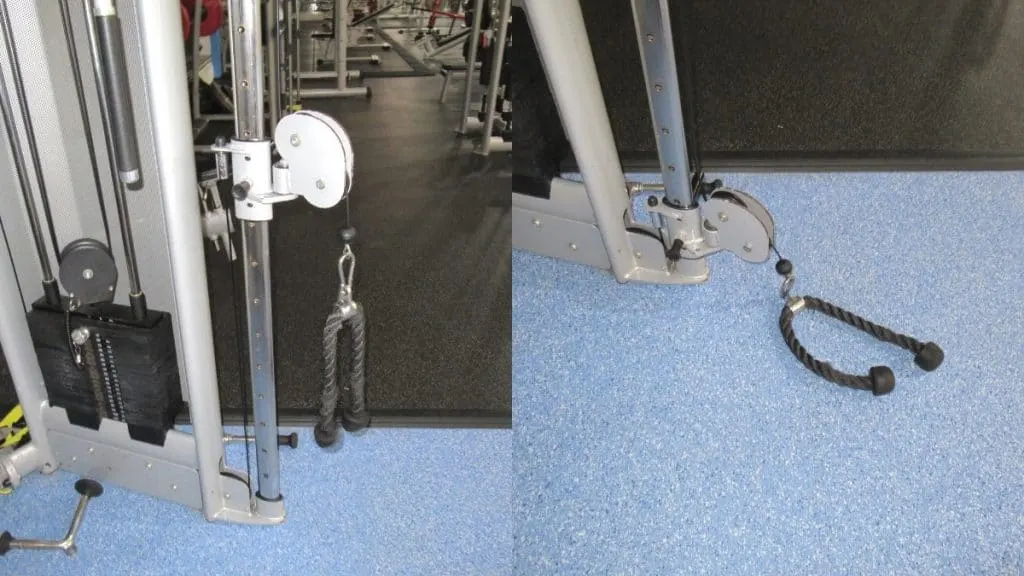
As mentioned, doing rope overhead tricep extensions with the pulley at waist height rather than above your head places your triceps under a greater eccentric stretch because the cables have to travel further when the pulley is in a low position.
So while using a high pulley position for cable rope extensions isn’t necessarily wrong, it’s not optimal for training the biggest head of the triceps—the long head—because, unless you literally bend your torso over to 90 degrees, it doesn’t place your triceps under a deep stretch, which is the whole point of doing this exercise.
On the other end of the spectrum, using the lowest possible pulley position isn’t necessarily incorrect either (it’s much better than using a high position), but it can make getting the rope into position very awkward indeed. This is because, since the cables are so “stretched,” they’re always trying to pull you backward, which can make you feel off-balance.
Your best bet is to use an adjustable cable station where you can position the pulley at waist height.
This setup gives you the best of both worlds: A great triceps stretch without having to heave the rope up and over your head.
Performing partial reps
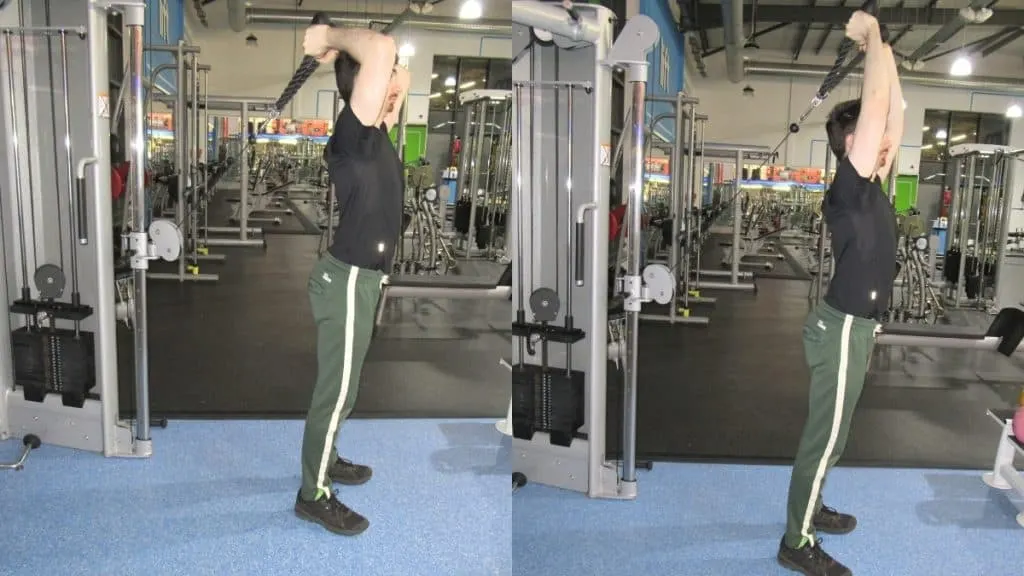
Many lifters perform partial reps during the cable overhead tricep extension because they’ve been taught that half reps maximize the pump and give their muscles a better workout.
While partials certainly increase your pump, they don’t give you a better workout unless you implement them smartly as part of a hypertrophy training program (i.e., not every session and certainly not every set).
The triceps brachii, after all, is an elbow extensor. [4] So in order to work your triceps muscles optimally, you have to lock your elbows out during the overhead cable extension because that’s their primary function.
Similarly, you need to lower the rope behind your head in a controlled manner until you feel that unmistakably intense stretch in the long head of your triceps.
The long head, as mentioned, is the largest head of the triceps and the only one that acts on the shoulder joint. So in order to grow your long head to its full potential, you can’t skimp on the eccentric portion of the rep either because this is where it receives its growth-stimulating stretch.
You need to bring the rope right behind your head and then flex your triceps until your elbows reach full extension if you want to get the best results (note that this may mean reducing the resistance initially).
Using momentum

Performing a leaning triceps extension with a rope usually means bending your knees and hips, and it always involves hinging at your waist. That’s right; there’s no textbook form for this suboptimal rope tricep extension variation; whatever position produces the best pump for someone is the position that they recommend for everyone else.
As you can see, having no clear idea of the proper form leaves you open to lifting the weight with momentum, which is why you should do the standing cable tricep extension instead.
Using momentum, on the other hand, does nothing but skyrocket the torque going through joints, which in turn increases your injury risk. Although swinging the rope with the help of various joints besides your elbows does let you lift more weight, that extra resistance isn’t going directly to your triceps; it’s getting distributed to the other muscles that you’re using to cheat.
Thus, lifting with momentum provides no extra triceps stimulation.
Overhead rope extension sets and reps
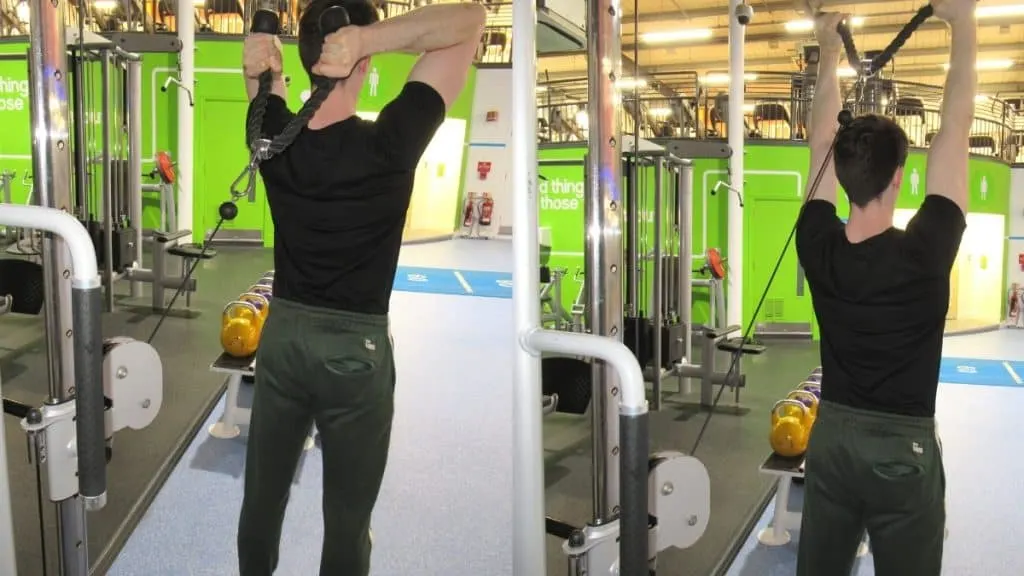
Performing the overhead tricep extension cable style taxes your triceps with constant tension because, unlike with free-weight equivalents, your muscles can’t rest at any point during an overhead cable extension set because the pulley is constantly exerting some kind of force on your triceps.
As such, the overhead tricep cable extension is especially effective for getting a good pump via high-rep training because the constant tension of the cables greatly increases metabolite accumulation within your triceps.
For this reason, many lifters perform the rope overhead triceps extension for 3 sets of 15-20 reps at the end of their workout in order to recruit any remaining, stubborn muscle fibers while increasing their pump.
Yet, the low pulley rope tricep extension is also well-suited to heavy, low rep training for two reasons: First, because the triceps respond exceptionally well to heavy lifting due to their fast-twitch fiber composition, and second, because cables (since they require less stabilization than free weights), make heavy lifting more tolerable for your joints.
As such, performing 3-5 sets of 8-12 reps also makes sense. If you like the exercise enough, then there’s no reason why you can’t make the cable overhead extension your primary tricep exercise.
Read More: Cable overhead triceps extension alternative
Conclusion: Should you do overhead rope extensions for your triceps?
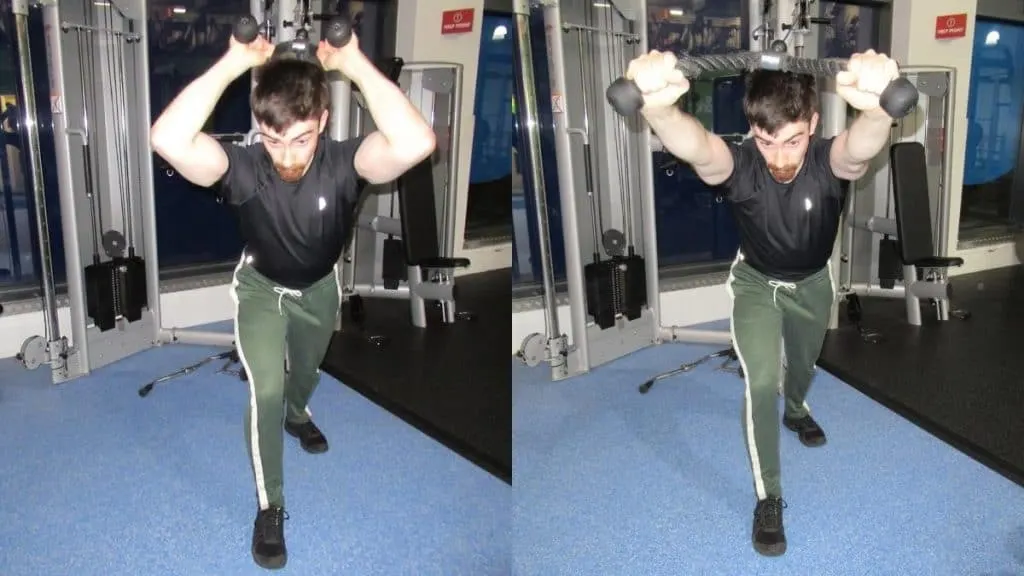
Whether you want to build mountains of muscle mass or just get a good triceps pump at the end of your workout (those goals aren’t mutually exclusive, by the way), the overhead cable extension is an exercise that’s well worth including in your training program.
With so many possible variations, the overhead cable tricep extension is an arm-strengthening exercise that just about any gym-goer can benefit from.
The rope attachment is most recommended because it promotes muscular symmetry and produces a powerful peak contraction. But if you don’t like the overhead rope tricep extension for whatever reason, then you can do the exercise with a bar instead.
Aim to position the pulley at waist height where possible (i.e., avoid using a high pulley) because it’ll provide your triceps with a better stretch while enabling you to maintain a rigid, upright torso that’s conducive to lifting with the proper form.
References
- Gorman, N. (2021, September 30). Elbow joint. Kenhub. https://www.kenhub.com/en/library/anatomy/elbow-joint
- Heffernan, A. (2020, August 29). How to Correct a Muscle Imbalance. Openfit. https://www.openfit.com/how-to-correct-muscle-imbalance
- BBC News. (2013, October 16). Calorie burner: How much better is standing up than sitting? https://www.bbc.co.uk/news/magazine-24532996
- Triceps muscle | anatomy. (2021). Encyclopedia Britannica. https://www.britannica.com/science/triceps-muscle

